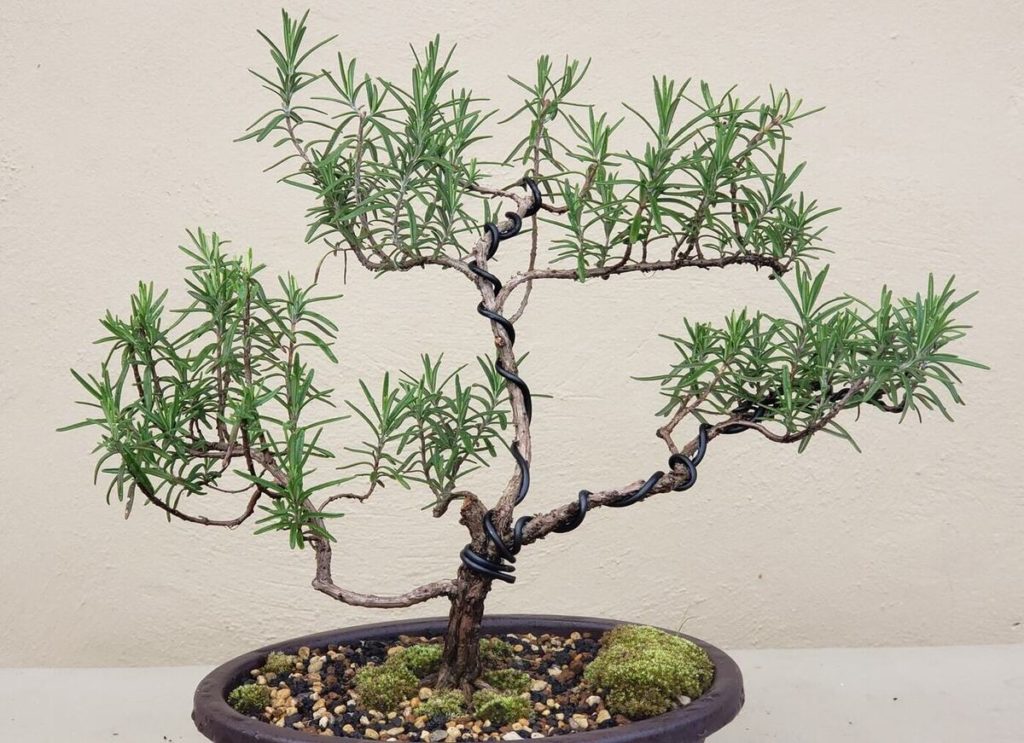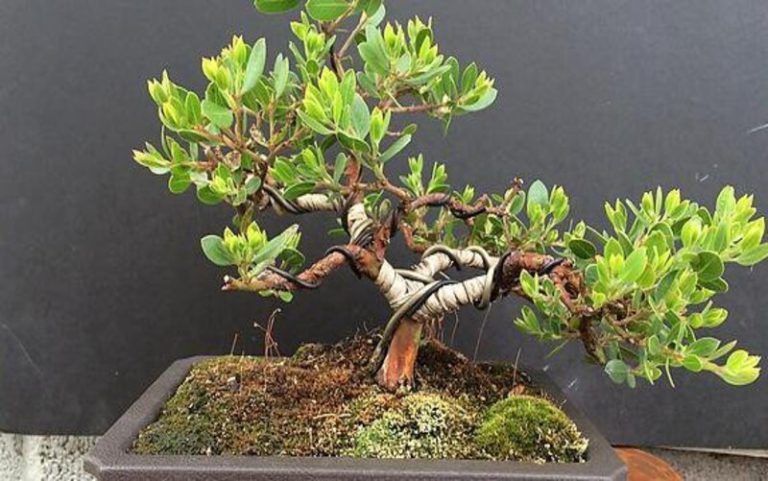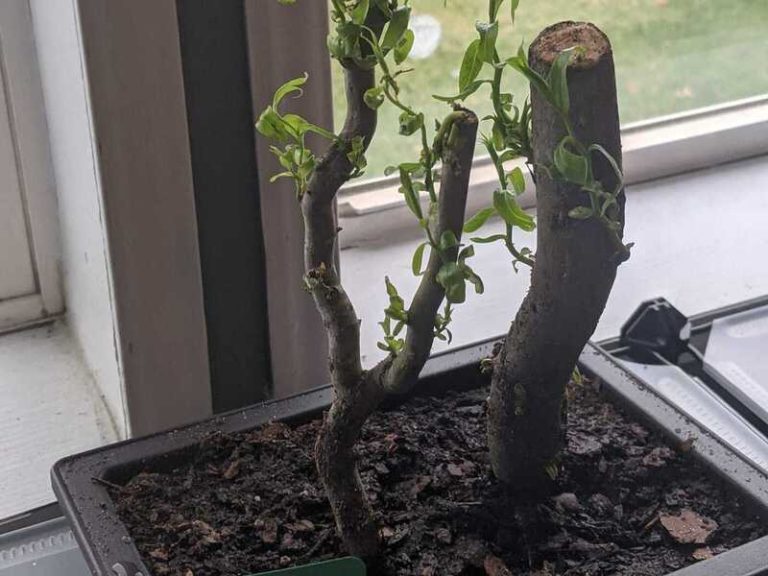Bonsai Rosemary : Bringing the Mediterranean to Your Home
The rosemary plant often seen in gardens may be reduced in size to make a charming bonsai. It’s a pretty plant that requires little attention and looks good either inside or out. The advantages of growing rosemary as a bonsai and tips for doing so are the subject of this essay.
What is Bonsai Rosemary?
Rosemary that is grown as a bonsai is a small form of a normal rosemary plant. “Bonsai” is the Japanese art of growing small trees or plants in a pot and shaping them to make them look a certain way. The same method is used to grow rosemary as a bonsai, but the goal is to make a small, compact form of the plant.
The plant is known for having small leaves that look like needles and a pleasant smell. It’s easy to take care of and can be grown both inside and outside.
Types of Bonsai Rosemary
Growing rosemary as a bonsai is possible with a few different species, all of which have their own quirks. Those that are most popular are listed below:
1.Blue Boy: This variety has blue-green foliage and produces small, light blue flowers in the spring.
2. Prostratus: This type of rosemary has a trailing habit and is often used in hanging baskets or as ground cover.
3. Tuscan Blue: This type is known for growing tall and straight and for having deep blue flowers. It smells very strong and is often used in cooking.
4. Miss Jessup’s Upright: This type of rosemary has a compact, upright growth habit and produces pale blue flowers in the spring.
5. Spice Island: This variety has narrow leaves and produces deep blue flowers in the summer. It has a strong, spicy aroma and is often used in cooking.
6. Golden Rain: This type of rosemary has yellow-green foliage and produces pale blue flowers in the spring.
7. Huntington Carpet: This variety has a low, spreading growth habit and is often used as ground cover. It produces pale blue flowers in the spring.
Overall, there are several varieties of bonsai rosemary to pick from, each with special qualities and applications.
Bonsai Rosemary and Its Symbolism
Bonsai rosemary, like many other bonsai plants, has a rich symbolism associated with it. Here are some of the common symbolic meanings of bonsai rosemary:
Longevity: Bonsai plants are frequently linked to longevity and the passage of time. This is due to the fact that the art of bonsai demands patience and attention, since it might take years to shape a plant into the proper shape. Bonsai rosemary is no exception, and with appropriate care, it may survive for many years.
Wisdom: Rosemary has long been associated with wisdom and remembrance, and is often used in traditional medicines and rituals. Bonsai rosemary can symbolize the pursuit of wisdom and the importance of remembering the past.
Resilience: People often think of bonsai plants as symbols of long life and the passing of time. This is because bonsai is an art that takes patience and hard work because it can take years to make a plant into the shape you want. Rosemary bonsai is no different. With the right care, it can live for many years.
Tranquility: Bonsai plants are often linked with peace and quiet because they can make any place feel calm and peaceful. With its pleasant smell and beautiful look, rosemary bonsai can help create a peaceful atmosphere anywhere.
Beauty: Finally, bonsai rosemary is often seen as a symbol of beauty and harmony. Its compact, miniature form and delicate leaves can create a sense of balance and elegance in any space.
Overall, bonsai rosemary has many different symbolic meanings, each of which can add depth and significance to its presence in a garden or home.

Characteristics of Bonsai Rosemary
Several characteristics of rosemary bonsai make it a popular choice among horticulture enthusiasts. Here are some of its primary attributes:
- Small size: Bonsai rosemary is a miniature version of the regular rosemary plant, which makes it perfect for small spaces or indoor growing.
- Fragrant aroma: Rosemary bonsai has a potent, agreeable scent that is frequently used in cookery and aromatherapy. The fragrance is released by rubbing or crushing the plant’s needle-like leaves, which generate the aroma.
- Evergreen leaves: Bonsai rosemary has evergreen leaves, which means they remain green and lush throughout the year. This makes it a great choice for creating a year-round garden or adding greenery to indoor spaces.
- Hardy: Rosemary is a tough plant that can grow in a wide range of situations, from drought to bad soil. Rosemary bonsai is no different; it can grow well in many different places.
- Medicinal properties: Rosemary has long been used in traditional medicine for its anti-inflammatory and antioxidant properties. Bonsai rosemary can be used in aromatherapy or brewed into a tea for its health benefits.
- Aesthetic appeal: Bonsai rosemary has a unique aesthetic appeal, with its miniature size and delicate leaves. It can be shaped into various bonsai styles, such as formal upright or informal upright, to create a beautiful and visually striking plant.
Overall, bonsai rosemary possesses a number of traits that make it an appealing and flexible plant for both indoor and outdoor cultivation.
How to Grow Bonsai Rosemary?
Growing bonsai rosemary can be a fun and rewarding project for gardening enthusiasts. Here are the steps to grow bonsai rosemary:
1.Choose a healthy plant: Start by selecting a healthy rosemary plant from a garden center or nursery. Look for a plant with strong, sturdy stems and healthy leaves.
2. Select a container: Choose a shallow container with good drainage holes. Bonsai pots are ideal, but any shallow container can work.
3. Plant the rosemary: Fill the container with soil that drains well, such as potting soil and perlite. Remove the rosemary plant carefully from its original container and replant it in the bonsai container. Wet the plant’s roots thoroughly.
4. Prune the plant: Use bonsai shears to prune the rosemary plant to shape it into the desired bonsai style. Prune the plant regularly to maintain its shape and size.
5. Water and fertilize: Bonsai rosemary needs to be watered regularly, but be careful not to overwater it. Allow the soil to dry out slightly between watering. Fertilize the plant every two weeks during the growing season with a balanced fertilizer.
6. Provide proper lighting: Bonsai rosemary needs plenty of sunlight to grow properly. Place the plant in a sunny location, such as a windowsill, where it can receive at least six hours of sunlight per day.
7. Monitor for pests and diseases: Watch for common rosemary pests such as spider mites, whiteflies, and aphids. Treat the plant with insecticidal soap or neem oil if pests are present.
By following these steps, you can successfully grow and care for bonsai rosemary. With proper care, your bonsai rosemary plant can thrive for many years, providing beauty, fragrance, and potential health benefits.
Benefit of Bonsai Rosemary
Bonsai rosemary is a versatile plant that offers many benefits. Here are some of the benefits of growing bonsai rosemary:
Aromatic fragrance: Rosemary bonsai has a strong, agreeable scent that is frequently used in cookery, aromatherapy, and perfumery. The aroma can aid in reducing tension and promoting relaxation.
Culinary uses: The fronds of bonsai rosemary can be used to add flavor to dishes while preparing. Rosemary is a prevalent herb used in Mediterranean cuisine, and it complements meats, vegetables, and condiments well.
Medicinal properties: Rosemary’s anti-inflammatory and antioxidant properties can aid in enhancing digestion, enhancing memory and concentration, and lowering the risk of chronic diseases.
Ornamental value: Bonsai rosemary has a unique and attractive appearance, with its small size and delicate leaves. It can be shaped into various bonsai styles, such as formal upright or informal upright, to create a visually striking plant that can be used for decoration.
Low maintenance: Rosemary that is grown as a bonsai is a tough plant that can grow in a wide range of situations, including drought and poor soil. It doesn’t need much care and can be grown indoors or out.
Environmental benefits: Rosemary can help keep bugs away from your garden because it is a natural insect blocker. It can also bring in good bugs like bees and butterflies, which are needed to pollinate plants.
Overall, bonsai rosemary offers many benefits, including its aromatic fragrance, culinary uses, medicinal properties, ornamental value, low maintenance, and environmental benefits. By growing bonsai rosemary, you can enjoy these benefits and add a touch of beauty and fragrance to your home or garden.
Styling and Design of Bonsai Rosemary
Bonsai rosemary can be styled and designed in various ways, depending on your personal preference and the overall aesthetic you want to achieve. Here are some common bonsai styles for rosemary:
- Formal Upright Style: This is a popular style for bonsai rosemary, where the trunk grows straight up with branches arranged in regular tiers. The overall shape resembles a cone, with the foliage becoming denser towards the top.
- Informal Upright Style: In this style, the trunk has a more organic and irregular shape, resembling a tree growing in nature. The branches are arranged asymmetrically, creating a more natural and relaxed appearance.
- Cascade Style: To get this look, the rosemary’s trunk needs to be trained to grow down like a waterfall. The branches and leaves grow in a fluid, moving way down the tree.
- Literati Style: This style is characterized by a tall, slender trunk with sparse foliage arranged in a haphazard manner. The overall appearance resembles a tree growing on a windy mountaintop.
- Windswept Style: In this fashion, a tree appears to be thriving in a blustery setting. The tree is given a sensation of motion and tension by having its trunk and branches directed to grow in one way and the foliage placed in the opposing direction.
This style makes it look like a tree is growing in a rough, windy place. The trunk and branches are taught to grow in one way, while the leaves are placed on the opposite side. This creates a feeling of movement and tension.

How to Care and Maintain Bonsai Rosemary
Proper care and maintenance are required to maintain your bonsai rosemary alive and well. Here are some pointers for caring for and maintaining your bonsai rosemary:
Watering: Bonsai rosemary prefers to grow in well-draining soil, so it’s important to water it regularly but not excessively. Allow the top layer of soil to dry out before watering again, and avoid getting water on the foliage.
Fertilizing: Bonsai rosemary benefits from regular fertilization during the growing season. Use a balanced, water-soluble fertilizer every two weeks or as directed by the manufacturer.
Pruning: Regular pruning is essential for maintaining the shape and size of your bonsai rosemary. Use sharp, sterile pruning shears to remove dead, diseased, or overgrown branches.
Pinching: Pinching is a technique that involves removing the tips of new growth to encourage branching and promote a denser foliage. Pinch the tips of new growth with your fingers or scissors when the shoots are about 2-3 inches long.
Repotting: Bonsai rosemary should be repotted every 2-3 years to maintain its health and prevent root-bound. Use a well-draining soil mix and a pot that is slightly larger than the current one.
Sunlight: Bonsai rosemary thrives in full sunlight, so place it in a location that receives at least 6 hours of direct sunlight per day.
Pests and Diseases: The rosemary used in bonsai is usually resistant to most diseases and pests. However, spider mites, mealybugs, and root rot are all potential threats. Keep an eye out for any symptoms of pests or illness on your plant, and if required, apply a fungicide or pesticide.
Bonsai Rosemary Care Sheet
| Aspect | Care Tips |
| Watering | Water regularly, but avoid overwatering. Allow the soil to dry out before watering again. |
| Fertilizing | Use a balanced, water-soluble fertilizer every two weeks during the growing season. |
| Pruning | Regularly prune to maintain shape and remove dead or overgrown branches. |
| Pinching | Pinch new growth to promote branching and denser foliage. |
| Repotting | Repot every 2-3 years to prevent root-bound. Use well-draining soil and a slightly larger pot. |
| Sunlight | Place in a location that receives at least 6 hours of direct sunlight per day. |
| Pests and Diseases | Inspect regularly for pests or disease. Treat with insecticide or fungicide as necessary. |
By following these care and maintenance tips, you can ensure that your bonsai rosemary remains healthy and beautiful for years to come.
Conclusion:
Bonsai rosemary is a beautiful and beneficial plant that is easy to grow and maintain. It adds aesthetic value to any setting and provides medicinal and culinary benefits. With proper care, bonsai rosemary can thrive indoors or outdoors, making it a great addition to any home or garden. Try growing bonsai rosemary today and enjoy the benefits it provides!
FAQ:
Q: What is a Bonsai Rosemary?
A: A Bonsai Rosemary is a small, compact version of the Rosemary plant, which is grown in a pot or container and trained to have a miniature tree-like appearance.
Q: How do you care for a Bonsai Rosemary?
A: To care for a Bonsai Rosemary, provide it with well-draining soil, regular watering, balanced fertilization, pruning, and pinching. Place it in a location that receives at least 6 hours of direct sunlight per day. Inspect regularly for pests or disease.
Q: How often should I water my Bonsai Rosemary?
A: Bonsai Rosemary prefers well-draining soil, so water it regularly but do not overwater. Allow the top layer of soil to dry out before watering again. Avoid getting water on the foliage.
Q: Can I grow Bonsai Rosemary indoors?
A: Yes, you can grow Bonsai Rosemary indoors, but it requires a bright and sunny location to thrive. Consider using artificial lighting if necessary.
Q: What kind of soil is best for Bonsai Rosemary?
A: Bonsai Rosemary grows best in dirt that drains well. For better drainage, mix loose sand or perlite with peat moss or compost, which are both high in organic matter.
Q: How do I prune my Bonsai Rosemary?
A: Regular pruning is essential for maintaining the shape and size of your Bonsai Rosemary. Use sharp, sterile pruning shears to remove dead, diseased, or overgrown branches. Prune back to a healthy lateral branch or just above a set of leaves.
Q: How often should I fertilize my Bonsai Rosemary?
A: Use a balanced, water-soluble fertilizer every two weeks during the growing season. Follow the instructions on the package.
Q: How do I prevent pests and diseases in my Bonsai Rosemary?
A: Regularly inspect your plant for signs of infestation or disease, and if necessary, apply an insecticide or fungicide. To maintain the plant’s health and resilience, provide proper care such as regular irrigation and fertilization.
Also Read:








